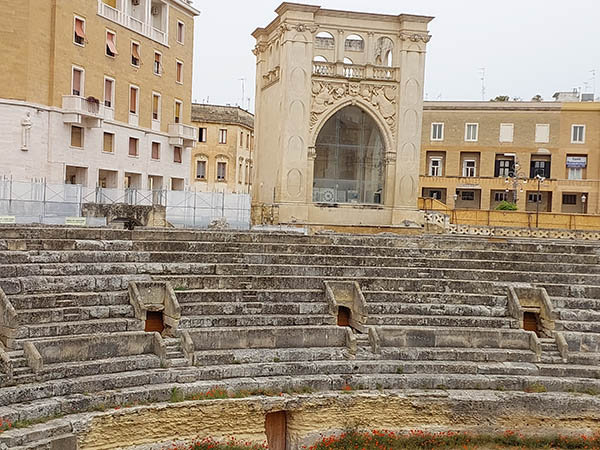|
Retire Early
Lifestyle
Retirement; like your parents, but way cooler

|
In 1991 Billy and Akaisha Kaderli retired at the age
of 38. Now, into their 4th decade of this
financially independent lifestyle, they invite you
to take advantage of their wisdom and experience. |
|
The Roman Amphitheater
of Lecce, Italy
Billy and Akaisha Kaderli
Currency Converter
Can you imagine - in the
city where you live - that while digging the foundation of a bank, a long-buried
ancient Roman ruin is discovered?
That's exactly what
happened in 1938 when the Bank of Italy was building their branch in Lecce,
Italy.
The construction workers
discovered a Roman Amphitheater!!
---- Right in the middle of
the city at Piazza Sant'Oronzo, the town's core.---
Take a look.

The column of Sant’Oronzo on the right and
the Palace of the National Insurance (INA) on the left
Lecce’s
Roman amphitheater was once five stories high.
It seated 25,000 spectators and
hosted gladiator bouts to entertain the legions of Roman soldiers in the city at
the time.
After the fall of the Roman Empire, the amphitheater fell into disuse and was
later buried beneath the ground as the city grew and evolved.
It became completely hidden from view
and its existence forgotten.

This ancient Roman Amphitheater was
re-discovered less than 100 years ago!
I can only imagine how startled everyone in
town was at the unearthing of such an archaeological find.
Right now, it is possible to see only a third of the entire structure, as the
rest is still hidden under the Piazza Sant'Oronzo. Other important historical
buildings are located here as well as the church of Santa Maria della Grazia.
However, there are tours available to see the
underground pens and passageways.

The buildings of the city and the Roman
Amphitheater built of Lecce stone
The whole historical center of Lecce has an
unusual yellow-creamy appearance, due to a particular limestone found in this
area of southern Italy.
It's sometimes called
"Lecce stone" and you can see how the city looks being built of this material.
Underneath this arena are the enclosures that
once housed animals, prisoners, and slaves.
Legions of Roman soldiers were entertained by
shows of blood shedding competition such as gladiators fighting with bulls,
lions, bears, or even other humans.
These wild and exotic animals were brought
here from the far boundaries of the Roman Empire. The animals fought each
other to the death, or gladiators would fight them.
Gladiators also battled
against those who were sentenced to execution and there were clashes among the
gladiators themselves.
Apparently there was a
designated time schedule for these collisions.
Battles between animals or between
gladiators and animals were planned for the mornings. Public executions occurred at
lunch time and the combats between gladiators occurred in the afternoon.
Now, if you ever have the
doubt that humanity has not improved over the millennia, consider that we no
longer host these sort of displays in our sport stadiums today!

To the right is the Church of Santa Maria della Grazia
It must have been a great decision - in the
midst of so much physical historical evidence over the centuries - to determine
which buildings must stay and which ones could be demolished in the unearthing
of this theater.
This area of the Piazza is a mish-mash of
architecture.
The Roman column which you see here to the
right is one of two that the Romans built to signify the end of their famous
Appian Way and was built in the year 110. The other column is located in
Brindisi, and this one was gifted to Lecce in in 1659.
It is now topped by Oronzo – the Patron Saint
of Lecce, who is credited for sparing the town from the plague in 1656.
The amphitheater today is used for more peaceful pursuits, including a summer series of concerts
and plays. It hosts a Nativity Scene at Christmastime as well.
The inside is not always open to the public, and
when we were here, there were no tours offered.

A collection of Lover's locks
It is common in Europe and
in
Mexico to have places where Lovers inscribe locks with their names or
initials. Then these locks are gathered together at a significant location (such
as this Amphitheater) to signify the commitment of love that the couples have
for each other.
The Roman Amphitheater is
to the right after the wall.

A cafe at the theater location
We sat at this cafe for coffee and croissants
one morning across from the ancient amphitheater. Amazing!
It is a remarkable experience to be in this
century and witness the physical confirmations of civilizations of the past.
Romans used this town as a resort or a trading port along the Mediterranean,
and Lecce was conquered and occupied during the many invasions since then.
Buildings were built during Mussolini's
Fascist period and the city played a significant role in WWII.
People, culture, beliefs, and structures all
came and went.

Our bill
We were charged $6.70Euros - about $7USD for
1 cappuccino, 2 waters and 2 croissants, which are called cornettos here.
If you are in Lecce, make it a point to come
see the Roman Amphitheater.
Hopefully there will be a
tour available during your stay!
__________
Roman Amphitheater of Lecce
Piazza Sant'Oronzo
Phone: 0832247018
Make inquiries at the tourist information
office located on Piazza del Duomo.
For more stories, photos and videos of
Italy, click
here
For more on
Retirement Topics,
click here and
here

About the Authors



Retire
Early Lifestyle appeals to a different
kind of person – the person who prizes their
independence, values their time, and who doesn’t
want to mindlessly follow the crowd.
HOME
Book Store
Retire Early Lifestyle Blog
About Billy & Akaisha
Kaderli
Press
Contact
20 Questions
Preferred
Links
Retirement
Country Info
Retiree
Interviews
Commentary
REL
Videos
|